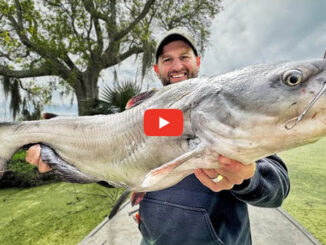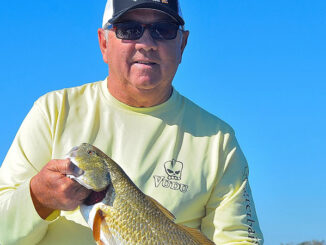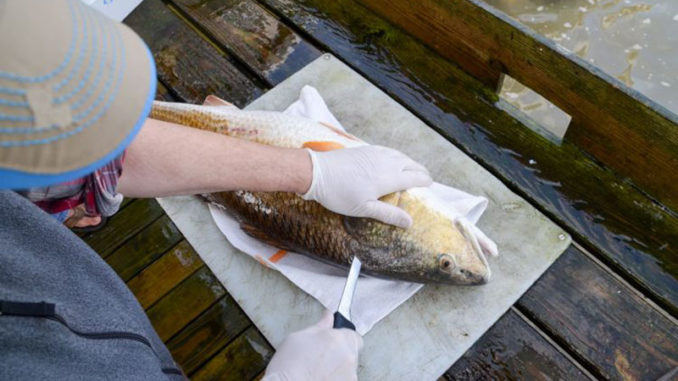
The topic of cleaning bull reds turns many anglers off.
“The average person throws them back — hard to clean, bloody, big head, taste bad,” Capt. Lloyd Landry said. “The problem is that most people don’t know how to clean them.”
Tenny Flynn certainly isn’t in that crowd, demonstrating that he knows as much about cleaning fish as about cooking them.
He is not only proficient at producing beautiful cutlets from fillets, but he cleans out the throat and cheeks of each bull red.
He wastes nothing, not even the belly meat, which he calls “the best-eating piece on the fish.”
One of the reasons many fishermen struggle to clean large redfish is that they cling to the electric knives they have adopted for use with soft-fleshed, small-boned species such as speckled trout.
Flynn uses four tools for fish cleaning: a large cimeter (a fancy modern spelling for scimitar) knife, a smaller boning knife, a sharpening steel to touch up the knives’ edges and a pair of fisherman’s pliers.
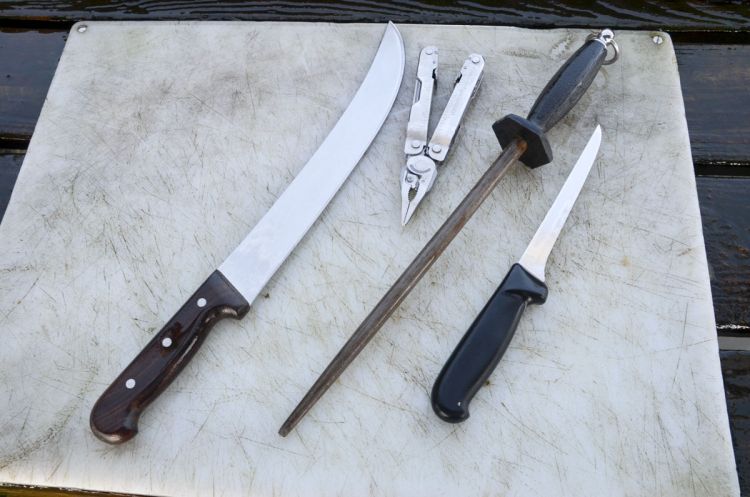 Here are his steps to prepping bull reds for the kitchen:
Here are his steps to prepping bull reds for the kitchen:
1) Insert the boning knife between the scales several scales behind the gill cover and cut vertically down to the backbone.
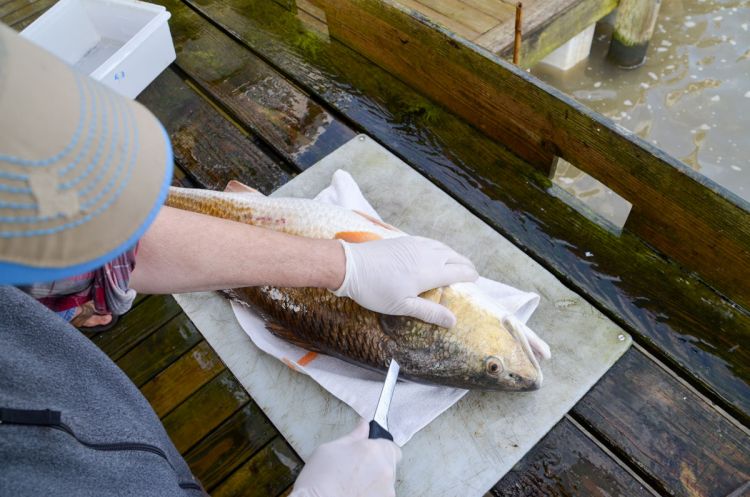 2) Laying the knife flat, deeply cut the length of the fish along the dorsal fin.
2) Laying the knife flat, deeply cut the length of the fish along the dorsal fin.
 3) Return to the cut behind the head and lengthen it down to the belly, curving forward to leave as much belly meat on the future fillet as possible.
3) Return to the cut behind the head and lengthen it down to the belly, curving forward to leave as much belly meat on the future fillet as possible.
 4) Using repeated small cuts, free the meat from the backbone down the length of the fish and cut the end of the fillet free from tail. Notice how little flesh is left on the backbone.
4) Using repeated small cuts, free the meat from the backbone down the length of the fish and cut the end of the fillet free from tail. Notice how little flesh is left on the backbone.
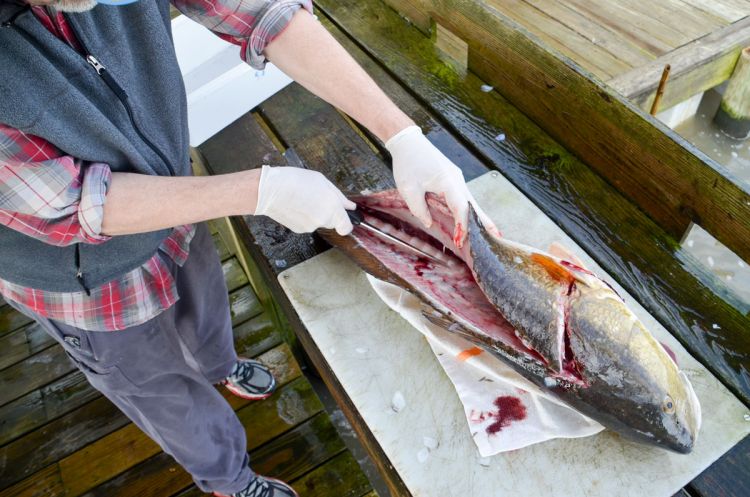 5) Again, using small cuts, cut the fillet free from the rib cage. Ride the blade of the knife close to the rib bones to avoid wasting belly meat.
5) Again, using small cuts, cut the fillet free from the rib cage. Ride the blade of the knife close to the rib bones to avoid wasting belly meat.
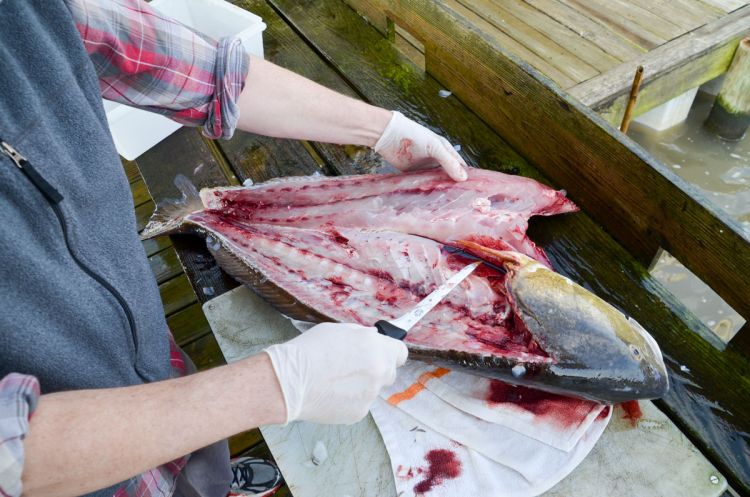 Free the fillet down to the belly, but leave the fillet temporarily attached to the frame at the belly. This makes it easier to cleanly fillet the second side of the fish.
Free the fillet down to the belly, but leave the fillet temporarily attached to the frame at the belly. This makes it easier to cleanly fillet the second side of the fish.
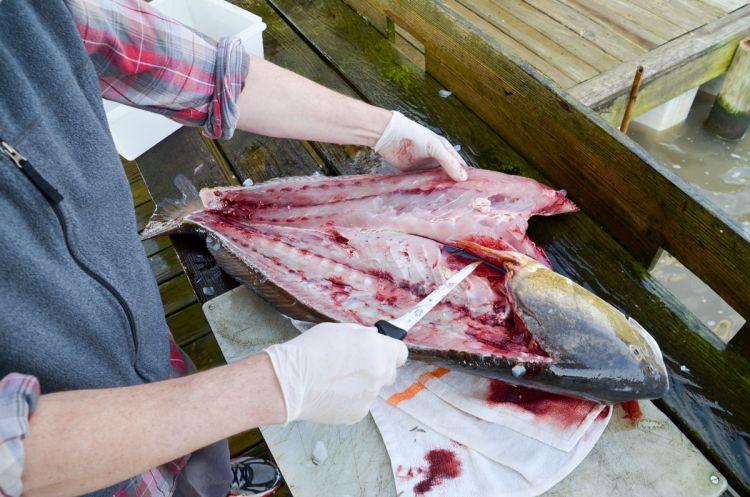 6) Turn the fish over and tuck the loosened fillet in place beneath it. Repeat all the steps above, and then cut the belly of each fillet free to detach it from the frame.
6) Turn the fish over and tuck the loosened fillet in place beneath it. Repeat all the steps above, and then cut the belly of each fillet free to detach it from the frame.
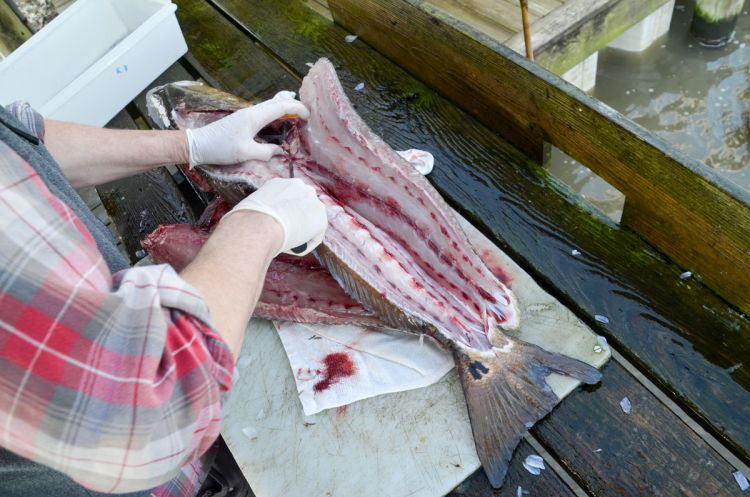 7) Trim and discard the inside skin from the belly flap of each fillet.
7) Trim and discard the inside skin from the belly flap of each fillet.
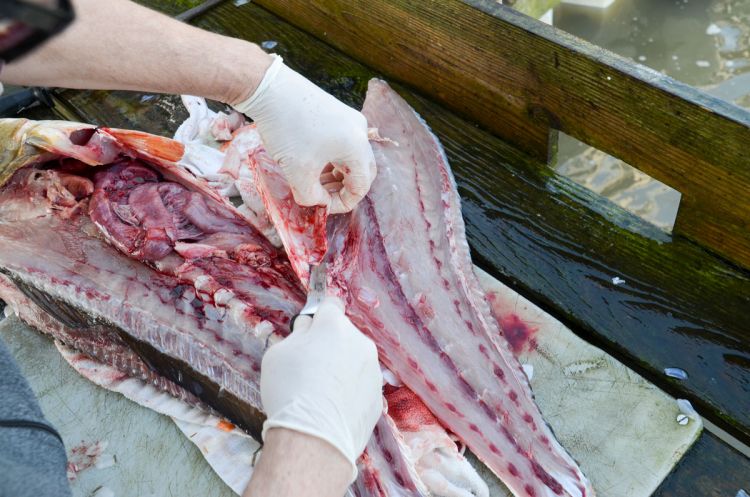 8) Use the cimeter knife to separate the skin from each fillet.
8) Use the cimeter knife to separate the skin from each fillet.
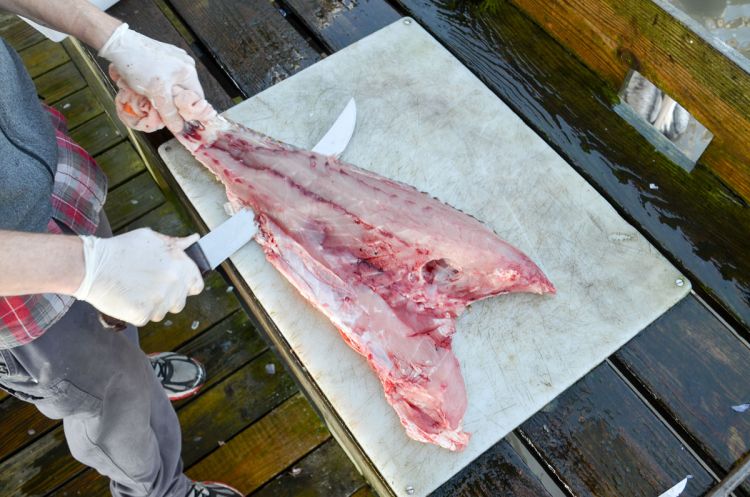 9) With the same knife, separate the knot of tender muscles at the base of the pectoral fin from the rest of the fillet and set it aside to cook with the throat.
9) With the same knife, separate the knot of tender muscles at the base of the pectoral fin from the rest of the fillet and set it aside to cook with the throat.
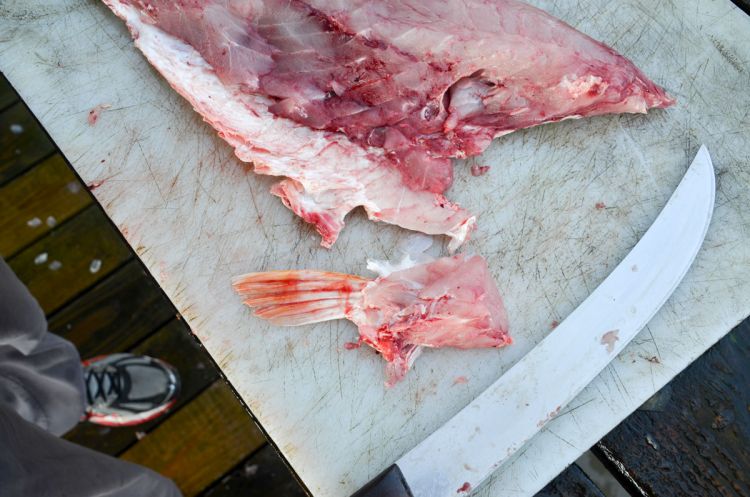 10) Use a thumb to feel along the forward part of the streak of red meat (aka the blood line) for the presence of pin bones. Pull and discard each pin bone found with pliers.
10) Use a thumb to feel along the forward part of the streak of red meat (aka the blood line) for the presence of pin bones. Pull and discard each pin bone found with pliers.
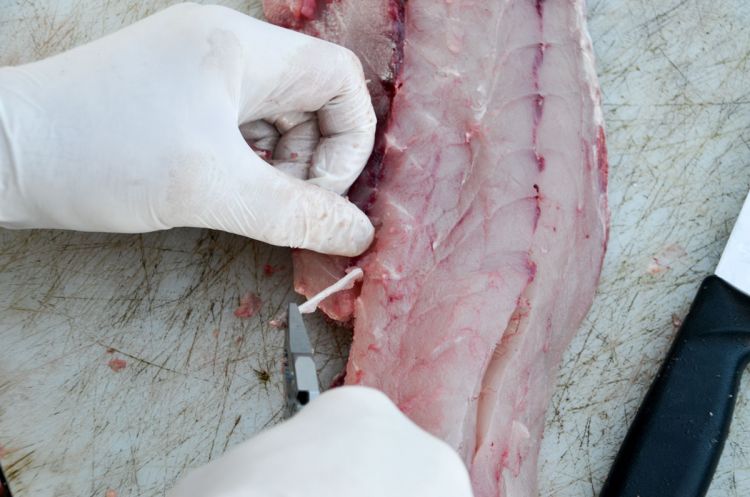 11) Separate each fillet down the blood line into two strips with the cimeter.
11) Separate each fillet down the blood line into two strips with the cimeter.
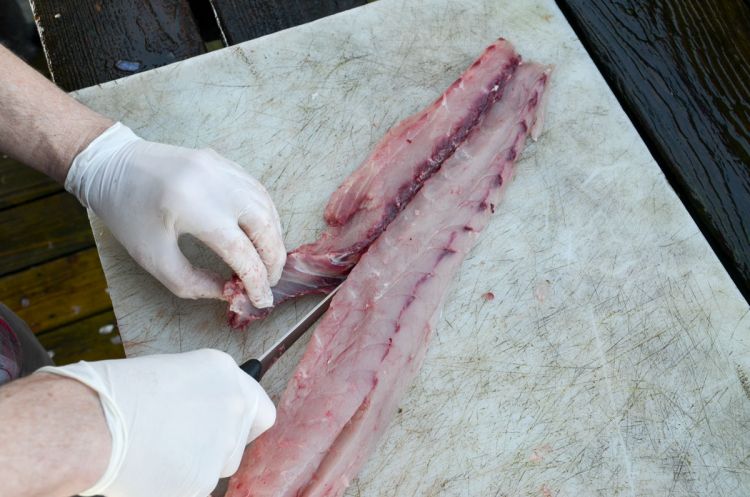 12) Use the same knife to remove and discard all the red flesh from each strip.
12) Use the same knife to remove and discard all the red flesh from each strip.
 13) Bias-cut each strip at an angle into multiple cutlets. This breaks the large fish’s connective tissue, making the flesh as tender as that of a small fish.
13) Bias-cut each strip at an angle into multiple cutlets. This breaks the large fish’s connective tissue, making the flesh as tender as that of a small fish.
 14) Use the large knife to separate the head, with the throat area still attached, from the backbone. Discard the backbone.
14) Use the large knife to separate the head, with the throat area still attached, from the backbone. Discard the backbone.
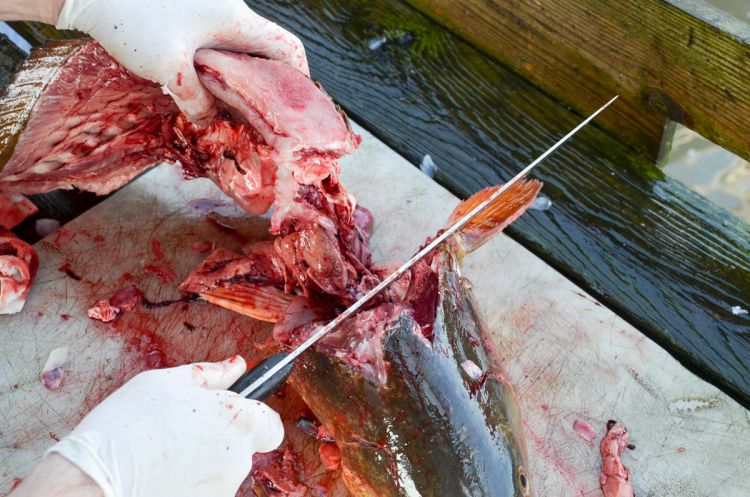 15) Use the boning knife to cut the throat free from the head by cutting at three points: directly under the head where the arch of muscle and bone meet, and on each side at the top of the gill arch.
15) Use the boning knife to cut the throat free from the head by cutting at three points: directly under the head where the arch of muscle and bone meet, and on each side at the top of the gill arch.
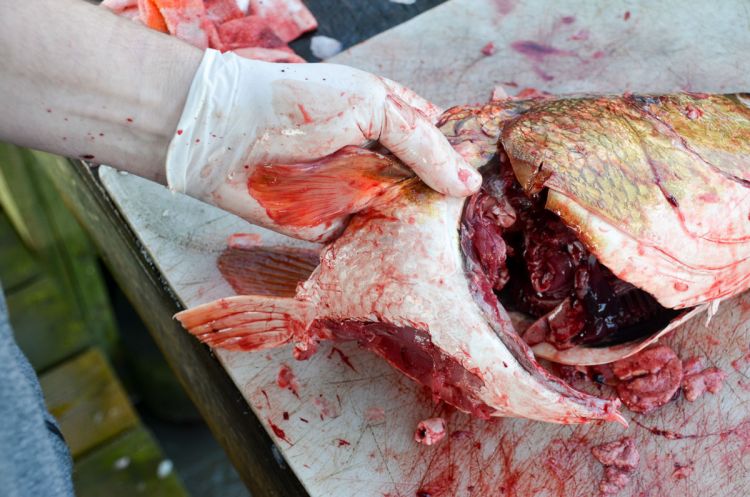 16) Scale the throat with the boning knife and cut it into two pieces, each with one pelvic fin on it. The large mass of muscles on each piece is very tender.
16) Scale the throat with the boning knife and cut it into two pieces, each with one pelvic fin on it. The large mass of muscles on each piece is very tender.
 17) Using a thumb, feel for the outline of the cheek muscles located beneath the eye. Use the boning knife to make a circular cut around the cheek, following the bony margin.
17) Using a thumb, feel for the outline of the cheek muscles located beneath the eye. Use the boning knife to make a circular cut around the cheek, following the bony margin.
 Cheeks are the most tender cut on a fish, and are surprisingly large on a bull redfish.
Cheeks are the most tender cut on a fish, and are surprisingly large on a bull redfish.
